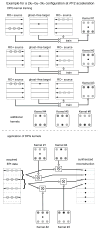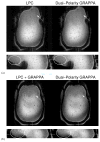Dual-polarity GRAPPA for simultaneous reconstruction and ghost correction of echo planar imaging data
- PMID: 26208304
- PMCID: PMC4758917
- DOI: 10.1002/mrm.25839
Dual-polarity GRAPPA for simultaneous reconstruction and ghost correction of echo planar imaging data
Abstract
Purpose: The purpose of this study was to seek improved image quality from accelerated echo planar imaging (EPI) data, particularly at ultrahigh fields. Certain artifacts in EPI reconstructions can be attributed to nonlinear phase differences between data acquired using frequency-encoding gradients of alternating polarity. These errors appear near regions of local susceptibility gradients and typically cannot be corrected with conventional Nyquist ghost correction (NGC) methods.
Methods: We propose a new reconstruction method that integrates ghost correction into the parallel imaging data recovery process. This is achieved through a pair of generalized autocalibrating partially parallel acquisitions (GRAPPA) kernels that operate directly on the measured EPI data. The proposed dual-polarity GRAPPA (DPG) method estimates missing k-space data while simultaneously correcting inherent EPI phase errors.
Results: Simulation results showed that standard NGC is incapable of correcting higher-order phase errors, whereas the DPG kernel approach successfully removed these errors. The presence of higher-order phase errors near regions of local susceptibility gradients was demonstrated with in vivo data. DPG reconstructions of in vivo 3T and 7T EPI data acquired near these regions showed a marked improvement over conventional methods.
Conclusion: This new parallel imaging method for reconstructing accelerated EPI data shows better resilience to inherent EPI phase errors, resulting in higher image quality in regions where higher-order EPI phase errors commonly occur. Magn Reson Med 76:32-44, 2016. © 2015 Wiley Periodicals, Inc.
Keywords: GESTE; Nyquist ghost correction; artifact correction; fMRI; oblique ghosts; parallel imaging.
© 2015 Wiley Periodicals, Inc.
Figures










References
-
- Feiweier T. Magnetic resonance method and apparatus to determine phase correction parameters. 8,497,681 US Patent. 2013
-
- de Zwart JA, van Gelderen P, Golay X, Ikonomidou VN, Duyn JH. Accelerated parallel imaging for functional imaging of the human. NMR in Biomedicine. 2006;19(3):342–351. - PubMed
-
- Wald LL, Polimeni JR. High-speed, high-resolution acquisitions. In: Toga AW, editor. Brain Mapping: An Encyclopedic Reference. San Diego, CA: Academic Press; 2015.
Publication types
MeSH terms
Grants and funding
LinkOut - more resources
Full Text Sources
Other Literature Sources

